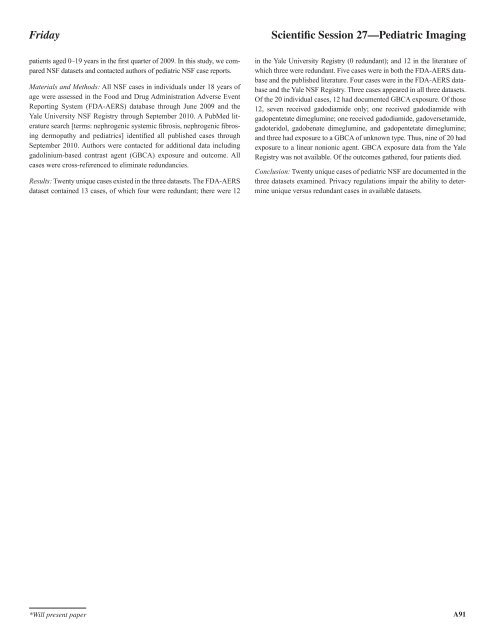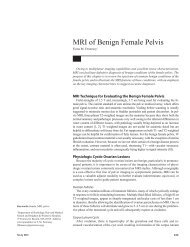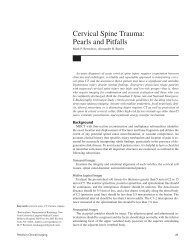<strong>Scientific</strong> <strong>Session</strong> 27—Pediatric <strong>Imaging</strong>Fridaytwo patients, the cystic structure had a prominent component protrudinginto the bladder lumen. In one of the patients, the cystic structure manifestedas a filling defect on VCUG. One patient presented with dysuriaand hematuria, one patient presented with an Escherichia coli urinarytract infection, and the three other patients lacked clinical signs or symptomsreferable to the urinary tract. Associated conditions included thrombocytopenia-absentradius syndrome in one patient and biliary atresia inone patient. The patient with dysuria and hematuria underwent partialcystectomy, with histologic examination of the specimen revealing a cysticurachal remnant with intestinal mucosa lining and extensive reactivelymphoid hyperplasia. The four other patients were managed conservativelywithout further intervention.Conclusion: Intravesicular urachal remnants are characterized on ultrasoundby thin-walled, cystic structures located along the midline anterosuperioraspect of the urinary bladder. The cysts may have a prominentintraluminal component that is visible on VCUG. Although these may bemanaged conservatively without surgical intervention if discovered incidentally,the potential risk for superinfection or malignant transformationas reported for other urachal remnant anomalies is unclear.237. Normal Epiphyseal Cartilage Thickness in the Kneesand Ankle in Normal Boys and Girls at Different Ages UsingSonographyPanghaal, V.*; Levin, T.; Trinh, A.; Castillo, B. Montefiore MedicalCenter, Albert Einstein College of Medicine, North Bergen, NJAddress correspondence to V. Panghaal (vickpanghaal@hotmail.com)Objective: To evaluate the cartilage thickness in the knee and ankle innormal children of different ages using sonography.Materials and Methods: Sonography of the right knee and ankle wasperformed in normal healthy children referred for abdominal sonographyfor nonrheumatologic indications using a 12-MHz linear transducer.The study was approved by our institutional review board. Images werereviewed by two radiologists independently. Distal femoral epiphysealcartilage and proximal tibial epiphyseal cartilage were measured in thecoronal plane at the medial aspect of the femoral tibial joint where theepiphyses approximated each other most closely in order to standardizethe imaging plane. Talar cartilage was measured from a midline longitudinalimage of the talus. Using multiple linear regression analysis, theaverage of three measurements at each site was correlated with patientage and mathematical equations were generated.Results: Sixty children (31 boys and 29 girls; age range, newborn to 21years; mean age, 9 years; median age, 7 years 11 months) were imaged.Inter- and intraobserver reliability was 0.97 at the tibia, 0.99 at the femur,and 0.98 at the talus. Distal femoral epiphyseal cartilage and proximaltibial epiphyseal cartilage thickness decreased with age in boys and girls.However, younger girls showed a more rapid decrease in cartilaginousthickness in the knees when compared with age-matched boys, whichresolved with increasing age. Girls demonstrated decreased cartilaginousthickness in the knee when compared with boys at all ages until their lateteens. Talar cartilage did not significantly differ with age or gender.Conclusion: Decreased epiphyseal cartilage thickness in the knees ofnormal growing children can be followed sonographically. Girls demonstratea more rapid decline of epiphyseal cartilage thickness than boys,however, in the later teens gender differences disappear. A mathematicalformula can be generated to predict cartilage thickness and may be usefulin detecting early cartilage loss in children with inflammatory arthritis.238. Use of 1.5-T and 3-T MRI to Evaluate Femoral HeadReduction in Hip DysplasiaChin, M. 1,2 *; Shoemaker, A. 1,2 ; Betz, B. 2,3 ; Reinhart, D. 2,3 ; Maples, D. 2,3 ;Halanski, M. 2,3 1. Grand Rapids Medical Education Partners, Grand Rapids,MI; 2. Michigan State University College of Human Medicine, GrandRapids, MI; 3. Helen DeVos Children’s Hospital, Grand Rapids, MIAddress correspondence to M. Chin (matthew.s.chin@gmail.com)Objective: To our knowledge, no comparison between 1.5-T and 3-TMRI scans has been performed in assessing hip reduction in patients withhip dysplasia. This study compares the use of these scans in assessinghip reduction.Materials and Methods: A retrospective review of 1.5-T and 3-T postreductionpelvic MRIs in patients with developmental dysplasia of the hipfor scanner time, anesthesia requirement, and subjective image qualityscores were performed. Intra- and interreader agreement of state of hipreduction was assessed. A scoring system was used to objectively compareMRI sequences between the 1.5-T and 3-T scans.Results: Of the 37 MRI scans, scanner time and anesthetic requirementwas not significantly different between 1.5-T and 3-T scans (p > 0.05).The 3-T scans showed slightly better image quality than 1.5-T scans (5.7vs 4.7), but the difference was not significant (p = 0.08). With regard tostate of hip reduction, intrareader Cronbach alpha was 0.89 with 1.5 Tand 0.98 with 3 T, while interreader agreement was 0.79 with 1.5 T and0.95 with 3 T, revealing greater consistency with 3 T. Mean anatomicscore comparison of hip anatomic markers showed no overall statisticaldifference between fast hip protocol sequences (f = 1.113, p = 0.346) ormagnet strength (f = 3.817, p = 0.053). Only the coronal T2-weighted fastspin-echo imaging demonstrated a statistically higher score on the 3-Tversus the 1.5-T (19.3 ± 9.3 vs 12.2 ± 6.7) scanner.Conclusion: Our study affirms that adequate images are obtainable withfast hip MRI without additional anesthesia. Good agreement was reachedon image quality and hip state of reduction between readers for 1.5-T and3-T scans, with more consistency with 3 T.239. Pediatric Nephrogenic Systemic Fibrosis: The Challenge ofCounting CasesSaddleton, E. 1 *; Haryani, A. 1 ; Laumann, A. 1 ; Raisch, D. 2 ; Cowper,S. 3 ; West, D. 1 ; Edwards, B. 1 ; Miller, F. 1 1. Northwestern University,Chicago, IL; 2. University of New Mexico, Albuquerque, NM; 3. YaleUniversity, New Haven, CTAddress correspondence to E. Saddleton (e-saddleton@northwestern.edu)Objective: The objective of this study was to evaluate the prevalence and associatedfeatures of pediatric nephrogenic systemic fibrosis (NSF). PediatricNSF is a rare yet life-threatening adverse event. To date, it has been exclusivelyseen in patients with compromised renal function. The UnitedStates Renal Data System reported 7704 cases of end-stage renal disease inA90*Will present paper
Friday<strong>Scientific</strong> <strong>Session</strong> 27—Pediatric <strong>Imaging</strong>patients aged 0–19 years in the first quarter of 2009. In this study, we comparedNSF datasets and contacted authors of pediatric NSF case reports.Materials and Methods: All NSF cases in individuals under 18 years ofage were assessed in the Food and Drug Administration Adverse EventReporting System (FDA-AERS) database through June 2009 and theYale University NSF Registry through September 2010. A PubMed literaturesearch [terms: nephrogenic systemic fibrosis, nephrogenic fibrosingdermopathy and pediatrics] identified all published cases throughSeptember 2010. Authors were contacted for additional data includinggadolinium-based contrast agent (GBCA) exposure and outcome. Allcases were cross-referenced to eliminate redundancies.Results: Twenty unique cases existed in the three datasets. The FDA-AERSdataset contained 13 cases, of which four were redundant; there were 12in the Yale University Registry (0 redundant); and 12 in the literature ofwhich three were redundant. Five cases were in both the FDA-AERS databaseand the published literature. Four cases were in the FDA-AERS databaseand the Yale NSF Registry. Three cases appeared in all three datasets.Of the 20 individual cases, 12 had documented GBCA exposure. Of those12, seven received gadodiamide only; one received gadodiamide withgadopentetate dimeglumine; one received gadodiamide, gadoversetamide,gadoteridol, gadobenate dimeglumine, and gadopentetate dimeglumine;and three had exposure to a GBCA of unknown type. Thus, nine of 20 hadexposure to a linear nonionic agent. GBCA exposure data from the YaleRegistry was not available. Of the outcomes gathered, four patients died.Conclusion: Twenty unique cases of pediatric NSF are documented in thethree datasets examined. Privacy regulations impair the ability to determineunique versus redundant cases in available datasets.*Will present paperA91
















